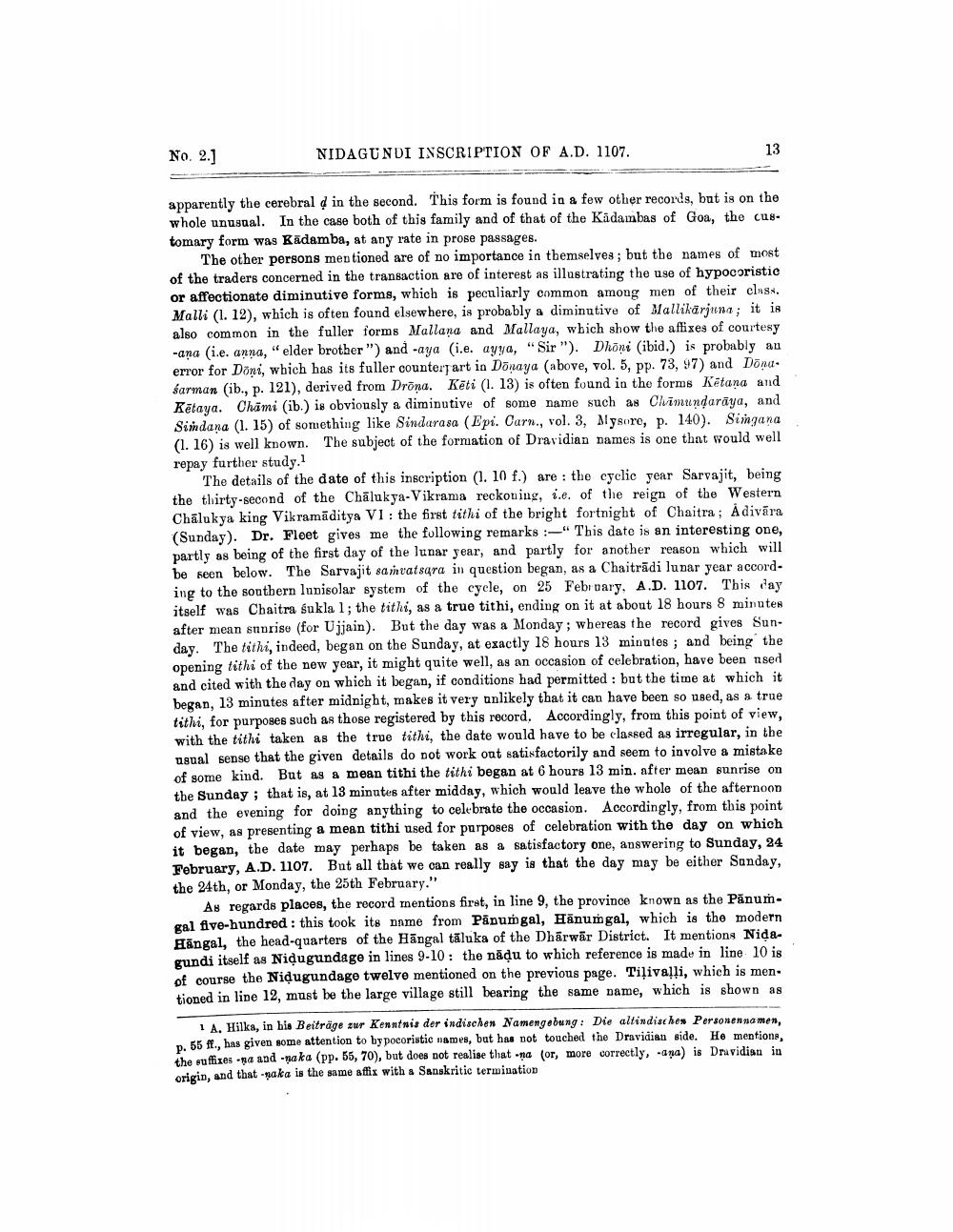________________
No. 2.)
NIDAGUNDI INSCRIPTION OF A.D. 1107.
apparently the cerebral d in the second. This form is found in a few other records, but is on the whole unusual. In the case both of this family and of that of the Kadambas of Goa, the customary form was Kadamba, at any rate in prose passages.
The other persons mentioned are of no importance in themselves; but the names of most of the traders concerned in the transaction are of interest as illustrating the use of hypocoristic or affectionate diminutive forms, which is peculiarly common among men of their class. Malli (1. 12), which is often found elsewhere, is probably a diminutive of Mallikarjuna; it is also common in the fuller forms Mallana and Mallaya, which show the affixes of courtesy -ana (i.e. anna, "elder brother") and -aya (i.e. ayya, "Sir"). Dhoni (ibid.) is probably an error for Dāni, which has its fuller counterpart in Dānaya (above, vol. 5, pp. 73, 97) and Dona. sarman (ib., p. 121), derived from Drona. Kēti (1. 13) is often found in the forms Kētana and Kētaya. Chāmi (ib.) is obviously a diminutive of some name such as Climundarāya, and Sindana (1. 15) of something like Sindarasa (Epi. Carn., vol. 3, Alysore, p. 140). Siingana (1. 16) is well known. The subject of the formation of Dravidian names is one that would well repay further study,
The details of the date of this inscription (1. 10 f.) are : the cyclic year Sarvajit, being the thirty-second of the Chālukya-Vikrama reckoning, i.e. of the reign of the Western Chalukya king Vikramāditya VI: the first tithi of the bright fortnight of Chaitra ; Adivāra (Sunday). Dr. Fleet gives me the following remarks :-"This date is an interesting one, partly as being of the first day of the lunar year, and partly for another reason which will be seen below. The Sarvajit samvatsara in question began, as a Chaitrādi lupar year according to the southern lunisolar system of the cycle, on 25 February, A.D. 1107. This day itself was Chaitra sukla 1; the tithi, as a true tithi, ending on it at about 18 hours 8 minuter after mean suprise (for Ujjain). But the day was a Monday; whereas the record gives Sunday. The tithi, indeed, began on the Sunday, at exactly 18 hours 13 minutes, and being the opening tithi of the new year, it might quite well, ag an occasion of celebration, have been used and cited with the day on which it began, if conditions had permitted : but the time at which it began, 13 minutes after midnight, makes it very unlikely that it can have been so used, as a true tithi, for purposes such as those registered by this record. Accordingly, from this point of view, with the tithi taken as the true tithi, the date would have to be classed as irregular, in the ugual sense that the given details do not work out satisfactorily and seem to involve a mistake of some kind. But as a mean tithi the tithi began at 6 hours 13 min. after mean sunrise on the Sunday ; that is, at 13 minutes after midday, which would leave the whole of the afternoon and the evening for doing anything to celebrate the occasion. Accordingly, from this point of view, as presenting a mean tithi used for purposes of celebration with the day on which it began, the date may perhaps be taken as a satisfactory one, answering to Sunday, 24 February, A.D. 1107. But all that we can really say is that the day may be either Sunday, the 24th, or Monday, the 25th February."
As regards places, the record mentions first, in line 9, the province known as the Pānumgal five-hundred : this took its name from Pānumgal, Hānumgal, which is the modern Hãngal, the head-quarters of the Hāngal tāluka of the Dhārwär District. It mentions Nidagundi itself as Nidugundage in lines 9-10 : the nādu to which reference is made in line 10 is of course the Nidugundage twelve mentioned on the previous page. Tiļivalli, which is men tioned in line 12, must be the large village still bearing the same name, which is shown as
1A. Hilka, in his Beiträge zur Kenntnis der indischen Namengebung: Die altindisches Personennamen, p. 55 ff., has given some attention to by pocoristic names, but has not touched the Dravidian side. He mentions, the suffixes na and-raka (pp. 55, 70), but does not realise that na (or, more correctly, dna) is Dravidisu in origin, and that taka is the same affix with a Sanskritic termination




